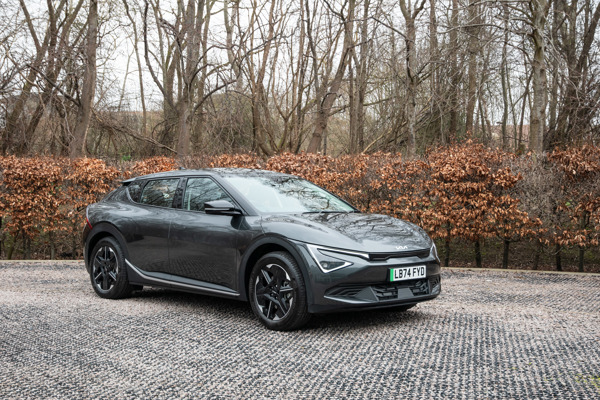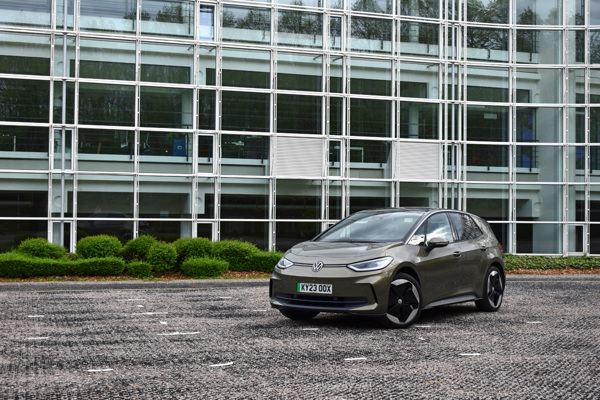Review
With its time on the Fleet News test car fleet coming to an end, the Citroen e-C4 will tick a lot of boxes for fleets and company car drivers.
A P11d price of £36,905 makes it competitively priced when compared to competitors such as the ID3 and MG4, while the addition of a the bigger 54kWh battery, coupled with an uprated 154PS electric motor, gives more range.
Okay, the 260 miles (WLTP) may have been hard to achieve, particularly when covering lots of motorway miles, but a range of more than 200 miles will be more than realistic for most drivers.
During its time with Fleet News, the highest electricity economy rate achieved – with eco-driving techniques employed – was 4.1 miles per kWh, giving a range of 221 miles on a single charge.
It averaged around 3.4mi/kWh while on test – somewhat shy of the 3.8mi/kWh required to achieve the 200-plus miles mark – but that was down to driving style and mix of roads travelled, rather than the e-C4’s technology.
In terms of kerbside appeal, personally, I think Citroen’s quirky design makes the e-C4 stand out from the crowd, while company car drivers will find a lot to like inside.
There is a 5.5-inch digital dash plus a 10-inch touchscreen, where you control many of the car’s functions.

Smartphone mirroring, Android Auto and Apple CarPlay, is also standard across the range, so you can use your own phone apps can be used instead of Citroen’s software.
Negatives with the e-C4 were few and far between. Its app could do with an overhaul and how Citroen chooses to display the range available – see previous update – is frustrating.
Drivers may also be surprised not to get the rapid acceleration associated with electric vehicles (EVs) – 0-62mph in 9.2 seconds (10 seconds for the 50kWh model).
However, many fleet managers will feel reassured that the acceleration of the e-C4 is not comparable to a supercar.
Real-world range tested
A 167-mile trip to mid-Wales should have been no trouble for the e-C4 given the 54kWh battery in our test vehicle.
With a claimed range of up to 260 miles between charges, thanks to the new, larger battery, it certainly looked good on paper.
However, having been averaging 3.2 miles per kWh, living with the e-C4 suggested that not charging enroute could leave me limping into the ‘land of my fathers’.
Setting off in the fully-charged e-C4, the desire to give it full beans was resisted to give the required range a fighting chance.
Combined with the free-flowing traffic of the A14 and M6, it paid dividends, with the electric crossover improving from 3.2 to 3.4mi/kWh within the first 60 miles.
The diminishing range displayed on the digital display started to be falling in line with distance being covered for once. Even if that wasn’t the case for the first part of my journey.
As mentioned before, while other battery electric vehicles (BEVs) display the range available to you, according to your ‘fuel’ economy rate, the e-C4 instead gives you its claimed range when fully charged.

Inevitably, those fictitious miles full away pretty quickly at the start of your journey and reality was finally being reflected in the range available by Birmingham.
With just over 90 miles to go, the e-C4 was showing north of 100 miles of charge available – I decided not to celebrate by accelerating along the M6 Toll.
The e-C4 does not deliver the surge of acceleration seen in most electric cars, managing 0-62mph in 9.2 seconds, which was not a bad thing when there was still 50-plus miles of rural roads to negotiate.
Pulling off the A5, however, with those 50 miles to go and my available range now showing 80 miles remaining, the winding, undulating tarmac would hopefully not dent the efficiency rate too much in the home straight.
It is probably worth saying at this point that in ‘normal’ circumstances, the e-C4 would have been plugged in for half an hour when a much-needed coffee was sought at Norton Canes Services.
However, for reasons that appeared a lot more sound at the start of my journey, choosing not to charge until I reached my destination would, I thought, make a better test.
With 10 miles to go and 15 miles range remaining, I was beginning to rue my logic.
My destination reached with 5 miles range remaining and an average efficiency rating of 3.3mi/kWh, the e-C4 may not have delivered its claimed range, but it at least avoided an anxious search for an emergency charger.
Roomier than you'd imagine
Larger than the VW Golf and about the same size as the ID 3, the Citroen e-C4 is roomier than you would first imagine.
Inside, the French manufacturer has upped its game over recent years and the e-C4 is no exception.
Everything feels well put together and the seats are really comfortable, with good lower back support if you are covering those motorway miles.
There is a 5.5-inch digital dash plus a 10-inch touchscreen with Apple CarPlay and Android Auto as standard. There are also dedicated buttons and knobs beneath for air conditioning and heated seats, alongside a couple of USB ports.
Below that you will find a wireless phone charger and an array of handy storage areas, while the tiny glovebox is probably the only downside.
A nice touch, however, is a slide-out tray in front of the passenger seat, which is just the right size for a tablet or laptop.
The e-C4 is roomy up front, comfortable enough for a six-footer, while the windscreen pillars are a bit imposing and the view out the rear window is not great thanks to that sloping roofline.
The spoiler does not completely obscure your view when using the rearview mirror, but you are helped by a reversing camera.
There is also no rear wiper which can make seeing out of the back even more problematic.
Two passengers can sit in the rear seats with surprising headroom despite that roofline and, while a bit of a squeeze if you are on the larger size, it can accommodate three bodies just.
The car has been designed so space is not compromised whether you opt for an electric C4 or one with an engine, giving our test car a 380-litre boot as standard.
There are also split-fold rear seats if you need a bit more space (1,250 litres), while the boot floor is height adjustable and there is underfloor storage for the charging cables.

Battery improvements boost range
Citroen has improved the all-electric powertrain on its e-C4 and e-C4 X models with the new battery and engine combination giving a claimed range of up to 260 miles between charges.
That’s a 17% improvement over the existing 50kWh battery option thanks to a 154PS electric motor – 20PS more than previously available – and the larger 54kWh battery.
The new battery is physically the same size as the old 50kWh unit but has greater energy density and is only available on the new range-topping e-Series trim level which we have on test.
As before, it supports rapid charging at to 100kW, with an 80% charge completed in around 30 minutes. A full charge using a 7kW wallbox charger takes a little over seven hours.
Having now driven Citroen’s funky crossover for the past three months, the first thing to mention is, unlike other electric vehicles (EVs), the e-C4 continues to display its claimed range when switched on.

While other EVs will display the range available to you, according to your driving style, the e-C4 pursues a glass half-full approach which to be honest isn’t very helpful.
The claimed figure on display in the cockpit just depletes rather quickly and your left wondering how many actual miles you have left in the battery.
Currently, it is averaging 3.2mi/kWh which suggests an actual range somewhere south of 200 miles.
Looking at the efficiency data available after different trips, it is possible to achieve a better return, but it is still somewhat shy of 260 miles.
Nevertheless, the 54kWh battery, improved electric motor and standard-fit heat pump make the updated e-C4 worth considering over the original version.
How does it compare to rivals?
A family five-door hatchback, the Citroen e-C4 finds itself pitched against the likes of the popular VW ID3 and MG4, but how does it compare on paper?
While the French manufacturer offers an entry-level model that has a P11D price just shy of £32,000, our top of the range test car, which comes with a 54kWh battery and a 156PS electric motor, has a P11D price of just over £37,000.
Using the Fleet News company car calculator, the e-C4 compares well with ID3 and MG4 models in similar trims and with similar battery sizes.
The 58kWh ID3, for example, which comes with a more powerful 204PS electric motor, has a P11D price of £37,860.
However, the MG4, which comes with a larger 64kWh battery paired with a 204PS electric motor, is more than £4,000 cheaper at £32,440.
From the employer’s perspective, Class 1A National Insurance costs for the e-C4 and ID3 are practically identical at £103 and £104, respectively, while the MG4 attracts less tax at just £90.
When comparing running costs, based on a 48-month/80,000-mile cycle, it is the greater depreciation of the e-C4 which leaves it trailing both the ID3 and MG4.
Not including Class 1A NICs, VED or insurance, the e-C4 has a running cost of 45.53 pence per mile (ppl), compared with 41.62ppm for the ID3 and just 37.7ppm for the MG4.
For service, maintenance and repair (SMR), which is included within the running cost calculation, the e-C4 comes out top at 3.47ppm, slightly less than the MG4 at 3.71ppm and much lower than 4.2ppm for the ID3.
The Citroen e-C4 is also top out of the three electric cars for fuel costs at 6.63ppm, while the ID3 and MG4 have figures of 7ppm and 7.75ppm, respectively.
It is the depreciation of the e-C4 which compromises its overall running cost coming in at 35.43ppm compared with 30.43ppm for the ID3 and just 26.24ppm for the MG4.
In terms of costs for a company car driver, all three models attract a benefit-in-kind (BIK) tax rate of 2% (2024-25).
It means that a 20% taxpayer would be paying £149 for the e-C4, slightly less than £151 for the ID3, but both more than the £130 for the MG4.
Citroen e-C4 54kWh joins our fleet
The all-electric Citroen e-C4 model range has been boosted by the arrival of a higher-powered, longer-range version.
Now available with Citroën’s latest-generation 54kWh battery technology and an uprated 154PS electric motor, the new all-electric powertrain helps the family hatchback achieve up to 260 miles between charges (WLTP).
It supports up to 100kW rapid charging, allowing 80% of the battery to be charged in 30 minutes depending on the power output of the charge point.
For home charging you get a Type 2 cable for free, allowing a regular 7.4kW charger to reach a 100% charge in seven hours and 30 minutes.
Having the ability to put the e-C4 through its paces over the next few months, it will be interesting to see how it performs in the real world.
But first impressions have been good, with the French manufacturer continuing to deliver design cues from an earlier era, giving the e-C4 bags of kerb appeal.

Our test car comes in Citroën’s recently introduced e-Series trim level, which is available across Citroën’s core electrified range – ë-C4, ë-C4 X, C5 Aircross Hybrid 136, and C5 Aircross plug-in hybrid, and delivers distinctive styling, additional interior features, and enhanced technologies.
There are three e-C4 models to choose from – Sense, E-Series and C-Series Edition, with the 54kWh and 154PS motor only available on the latter model.
All models get LED headlights, a 10.0-inch touchscreen, Automomous Emergency Braking (AEB), Lane Keeping Assist and Driver Attention Alert.
Th e-C4 still feels fresh and modern. There is a simple-looking digital dash and responsive infotainment set-up, which does involve extensive use of the touchscreen for many of the car’s functions.
On the road, meanwhile, you don’t get the surge of acceleration you get with many electric cars, but it gets up to cruising speed quickly enough and achieves 0-62mph in 9.2 seconds (10 seconds for the 50kWh model) and maximum speed for both is 93mph.
Specs
| Manufacturer | Citroen |
| Model | E-C4 Electric Hatchback |
| Specification | Citroen E-C4 Electric Hatchback 115kW E-series 54kWh 5dr Auto |
| Model Year | 2023.00 |
| Annual VED (Road tax) | £10 |
| BIK List Price | £36,905 |
| Range | 260.00mile(s) |
| CO2 | N/A |
| BIK Percentage | 3% |
| Insurance Group | N/A |
| CC | 1 |
| Fuel Type | Electric |
| Vehicle Type | Medium car |
| Luggage capacity (Seats up) | 380litres |
| Doors | 5 |
Running Costs
| P11D | £36,905 |
| Cost per mile | 52.15ppm |
| Residual value | £8,750 |
| Insurance group | N/A |
| Fuel Type | Electric |
| Cost per mile | 234.38ppm |
| Fuel | 2.05ppm |
| Depreciation | 229.35ppm |
| Service maintenance and repair | 2.98ppm |
Rivals
Info at a glance
-
P11D Price
£36,905
-
MPG
N/A (WLTP) -
CO2 Emissions
N/A -
BIK %
3% -
Running cost
3 Year 60k : £8,750 4 Year 80k : £6,975 -
Fuel Type
Electric -
Range
260.00mile(s)







































Login to comment
Comments
No comments have been made yet.